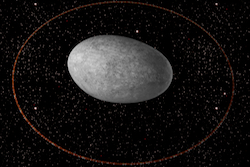Discovery of a ring around the dwarf planet Haumea
Located beyond Neptune, Haumea is one of five dwarf planets, a new category adopted by the International Astronomical Union in 2006 to accommodate new planetary findings. Haumea was first recognised in 2008 and compared to the other dwarf planets, Pluto, Ceres, Eris and Makemake, has remained the least understood. Researchers, supported by work from an EU-funded project LUCKY STAR, recently reported that they had used prediction models, coupled with observations taken in January 2017 by 12 telescopes across 10 European observatories, to accurately measure for the first time, Haumea’s size, shape and surrounding environment. Using stellar occultation to measure up It was previously known that Haumea took 285 years to rotate around the sun and that it was shaped like a rugby ball. However, as the researchers reveal in Nature, by exploring an area beyond Neptune’s orbit known as the the Kuiper Belt, they also discovered Haumea has a ring surrounding it which is estimated to be 290 Km in radius, 70 Km in width and with a 50 % opacity. Previously it was thought that rings were principally to be found around the four outer planets of Jupiter, Saturn, Uranus and Neptune. The Haumea ring rotates around the planet three times more slowly than the planet rotates around its own axis. According to Dr José Ortiz, one of the paper’s authors, the 70 Km wide ring is probably made of rock and ice. These frozen particles could be a result of the debris created by the impacts from stray rocks. It has also been suggested that the ring could have been created by the planet itself, as Haumea spins unusually fast, rotating once every 3.9 hours, and so could be hurling particles out into orbit. Additionally, the ring was discovered to be relatively remote from the planet (about 1 000 km above), which may be due to the ellipsoid shape of the planet. Haumea’s diameter is around one third the size of Earth’s moon and its longest axis as almost as long as Pluto’s diameter. Additionally, the planet has a large moon on the same plane as the ring, as well as a second smaller one. Secrets from the outer Solar System could prompt a rethink Until this latest finding, failed attempts to find rings around Pluto resulted in the proposition that no object farther afield than Neptune could sustain rings. Additionally, it had been thought that rings were chiefly the preserve of giant planets until, in 2014, the same researchers discovered rings surrounding asteroid-like objects known as Centaurs, orbiting between Jupiter and Neptune. Exploring the outer Solar System beyond Neptune is viewed as being highly scientifically instructive as the region could hold clues to the origin and evolution of the planetary system as a whole. It still contains unaltered primordial material and so ultimately holds a memory of early planetary migrations. The EU-funded LUCKY STAR project was set up to study Trans-Neptunian Objects (TNOs) and leads the field in using the technique known as ‘stellar occultation’, whereby shapes, atmosphere and rings of bodies, are revealed as they pass in front of the light emitted by stars. For more information, please see: CORDIS project page
Countries
France



